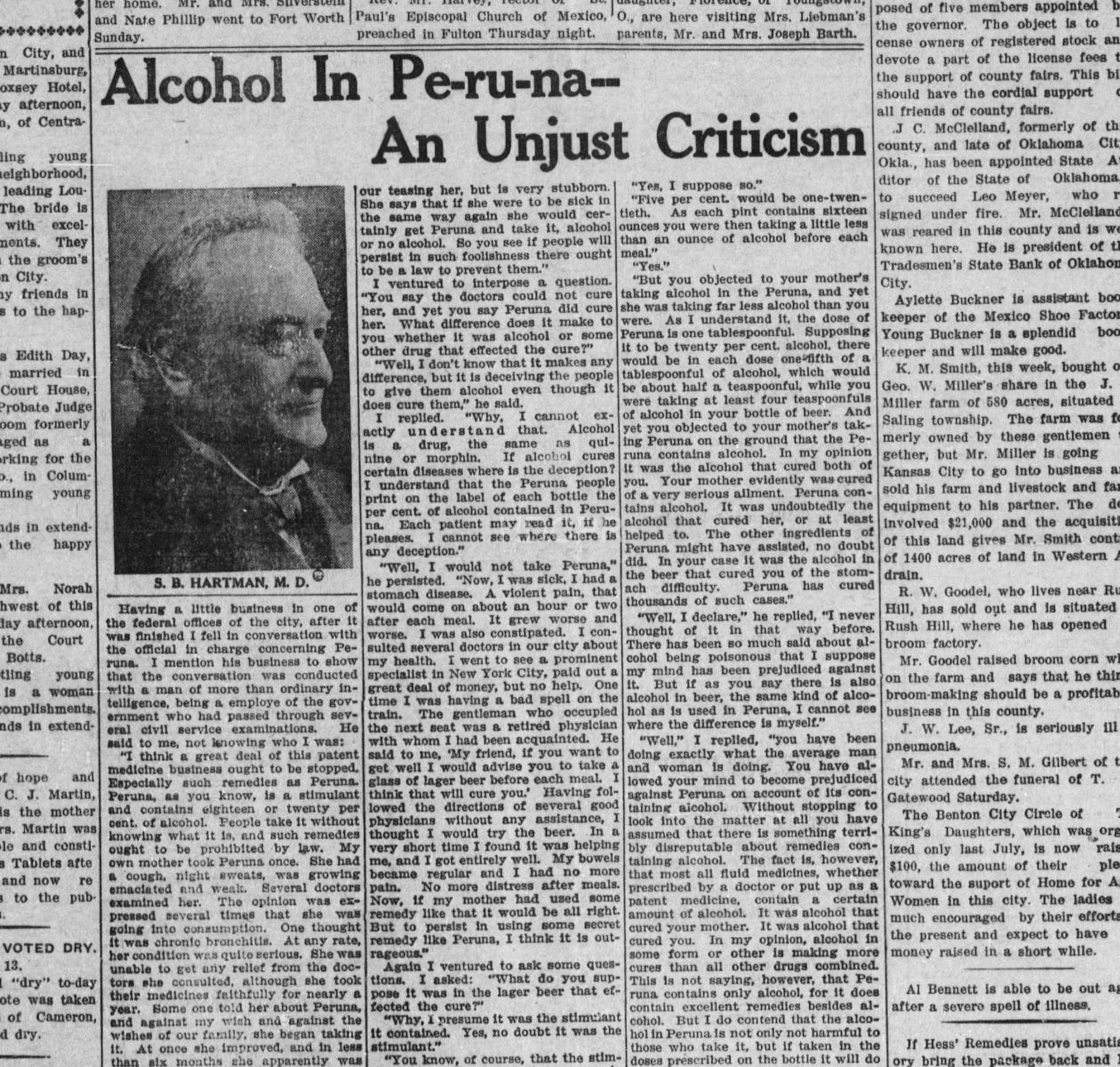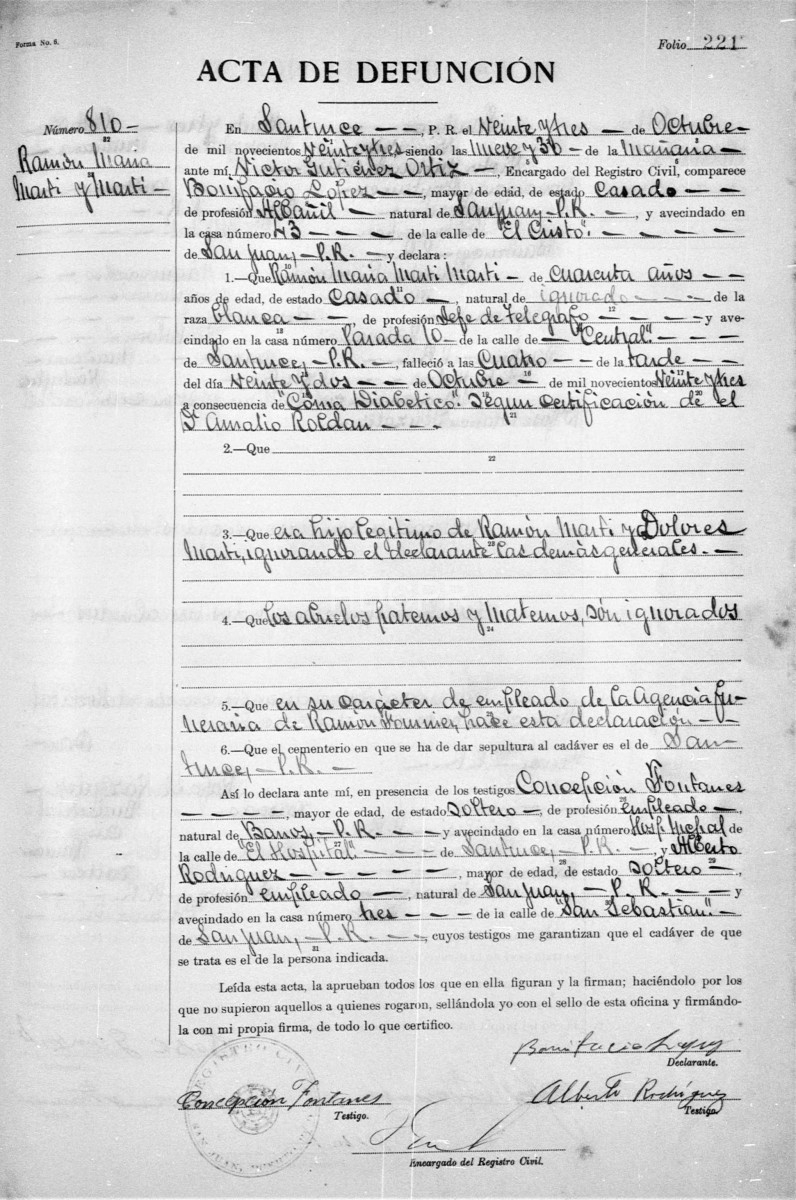Introduction
Peruna, A folk remedy hoax; a folk remedy is any purported health remedy from a pre-scientific source, usually through oral tradition.
Since we have been experiencing a pandemic for the last two years, the first since the Spanish Flu, I have done everything that was expected of me during this pandemic. I self-isolated, stopped socializing, avoided large crowds, stayed indoors as much as possible, and was fully vaccinated. In addition, I wore my mask at all times. But, it finally found its way to me, infecting me recently. As I write this article, I am still recovering from the symptoms. However, I am much better, but still far from where I was before I became another statistic.
With a background in Natural Medicine and Holistic Healing and as a former owner of a Natural Healing Business specializing in nutrition and herbs, I have always advocated natural healing for the body-mind. So it was no surprise to me when I read this article that I knew I would have to investigate. In addition, I wanted to know what became of Mr. Ramon Maria Marti, the man profiled in this article. But first, I investigated Peruna and the hoax behind it.
Catarrh Remedy and Peruna Scandal: Topics in Chronicling America
Do you have a stomach ache, headache, cough, or any illness at all? If so, it must be catarrh related…or not. During the latter half of the 19th century, the famous Dr. Samuel Hartman, created his world-renowned proprietary medicine, Peruna. He launched a vigorous advertisement strategy, which included hundreds of endorsements from politicians, business professionals, and many other regular citizens. However, despite his boundless success at the dawn of the 20th century, a journalist named Samuel Hopkins Adams displayed the scandal of the Peruna medicine.
Library of Congress
TIMELINE
| July 29, 1885 | By 1885, Dr. Samuel Hartman began to sell many prescriptions of Peruna and other medicines that were becoming widely popular. |
|---|---|
| July 27, 1898 | Peruna has been “securing freedom from the grip of catarrh and makes loyal friends for the liberator,” and Dr. Hartman encourages patients to buy his book, “Health and Beauty.” |
| December 17, 1902 | Peruna company claims that half of the human illnesses are catarrh in nature and that Peruna cures all forms of catarrh. As a result, many people have endorsed the product. |
| March 7, 1903 | Dr. Hartman personally claims a catarrhal “grip” has a great hold on America and “has found no remedy that equals Peruna for prompt action.” |
| February 5, 1905 | The Ohio home of Peruna, “the greatest medicine plant in the world,” is built on about seven acres of floor space. |
| October 20, 1906 | In his Collier’s Weekly article, journalist Samuel Hopkins Adams claims Peruna and other patent medicines are frauds. Specifically, he claims that Peruna contains 28 percent of alcohol. |
| January 9, 1907 | Testimony from Mr. Ramon Maria Martir appears in “La Democracia.” |
| February 20, 1913 | Dr. Hartman speaks out and claims alcohol in Peruna is “an unjust criticism.” |
| December 11, 1914 | The New York Tribune calls out for a “need of law to curb quack ‘cures'” including Peruna. |
| January 6, 1915 | Mr. Samuel Hopkins Adams again calls out patent medicines like Peruna, writing that advertisements cannot sell health. |
| February 1, 1918 | Dr. Samuel Hartman, age 88, died of acute indigestion in his apartment at the Hartman hotel. |
What is Peruna?
Peruna was a well-known patent medicine sold from the late 19th to the mid-20th century. It was patented by Samuel Brubaker Hartman and endorsed by hundreds of politicians. Hartman began selling the product on July 29, 1885, and advertised it as curing catarrh.
At its peak, Hartman was earning $100,000 a day from Peruna sales. The drug was reportedly so popular that babies were named after it, as was the mascot of Southern Methodist University. In addition, Peruna once released an ad with fifty United States Congressmen endorsing the product.
Boletin_Mercantil_de_Puerto_Rico_Tue__Sep_6__1904_Journalist Samual Hopkins Adam’s articles
In a series of eleven articles the journalist Samuel Hopkins Adams wrote for Collier’s in 1905, titled “The Great American Fraud,” he exposed many false claims about patent medicines. In addition, he points out that in some cases, these medicines damage the health of the people using them.

On October 20, 1906, Adams published an article claiming that Peruna and other such patent medicines were frauds, alleging that Peruna was 28% alcohol. The series had a huge impact and led to the passage of the Pure Food and Drug Act of 1906. In 1911, the Supreme Court ruled that the prohibition of falsifications referred only to the ingredients of the medicine.
Companies were again free to make false claims about their products. So Adams returned to the attack, and in another series of articles in Collier’s Weekly, he exposed the misleading advertising companies were using to sell their products.
Linking his knowledge of newspapers with patent medicines, he wrote the book The Clarion (1914), which was critical of newspaper advertising practices and led to a series of consumer protection articles in the New York Tribune. When prohibition came into effect, Americans began using Peruna and other similar products as a way to get large amounts of alcohol. However, the product had stopped being sold by the mid-1940s.
“La Peruna.” Testimony from Mr. Ramon Maria Marti Marti (Peruna Folk Remedy Hoax)
Below is the clipping I found in “La Democracia.” in 1907. La Democracia ran numerous ads like these in the early 1900s along with other local newspapers, El Boletin Mercantil de Puerto Rico and La Correspondecia.

PADECIÓ DE CATARRO POR DIEZ Y SEIS AÑOS
El administrador de Telégrafos De Aguadilla, Puerto Rico, Fué Admirablemente Curado Por la Pe-ru-na.
Carta del señor Ramón María Martí Administrador de Telégrafos de Aguadilla, Puerto Rico.
Hace en largo espacio de 16 años, venía padeciendo de un catarro, principalmente en el pecho, sin que pasase nunca, durante ese largo período de tiempo, 15 días sin que tuviese que resguardarme por efecto de un infusión fuerte de catarro y privándome, á veces hasta de comer, pues pedíael apetito por completo.
“De hace seis años, al levantarme, invertía más de media hora después de hacer innumerables enfuerzas para poder limpiar mi pecho de la flema que contenía.”
“Consultándo el caso con various facultativos, ya me hacían tomar expectorantes ya cualquiera otra cosas, perso el resultado era, que jamás podia consequir que el mal desapareciose, llegando, por lo tanato, á perder toda esperanza de consequir un remedio con que poder curarme.”
“¡Dios lo quiso! Un día hablando con mi cuñada quien había venijo con el objeto de pasar algunos meses es nuestra compañía, y, al tratarse algo sobre mi catarro, me dijo: ¿Porqué no puebra Vd. la Peruna? En Bayamón hadado muy bien resultado; citóme casos.
“En efecto, sin tener mayormente fé, me determiné a comprar un frasco de Peruna. Hace 15 días vengo tomandola, aún me quedan dos cucharadas en el primer frasco, y á esta fecha ya han desaparecido todos los afecciones catarrales; la flema que tanto me mortificaba por las mañanas y durante el día, desapareció por completo; mi pecho está tan limpio como cuando tenía ocho años; ¡y eso que me llegó á decir que el mal no tenía remedio!
“A indicaciones mías, más de 30 son están ya los que en esta villa toma su magnífico preparado, y todos sin excepeiór de un salo, muy agradecidos, no han podido menos que reconocer lo que reconozco yo, y es que PERUNA NO ES YA A EL MEJOR REMEDIO PARA EL CATARRO, SI NO ES EL ÚNICO.”
La Democracia 1907
English Translation of Article written by Mr. Marti (Peruna Folk Remedy Hoax)
He suffered from a cold for sixteen years.
The Pe-ru-na admirably cured the Administrator of Telegraph of Aguadilla, Puerto Rico.
Letter from Mr. Ramón María Martí, Administrator of Telegraphs of Aguadilla, Puerto Rico.
“I had suffered from a cold, mainly in the chest, for sixteen years.” During that long time, fifteen days without having to take shelter due to the effect of a strong infusion of cold and depriving myself, sometimes even to eat, because I lost my appetite completely.”
“From six years ago, when I woke up, I would spend more than half an hour after making countless efforts to be able to cleanse my chest of the phlegm it contained.”
“Consulting the case with various doctors, they offered expectorants and other remedies, but the result was that I could never get the illness to disappear, arriving, therefore, to lose all hope of finding a remedy to be able to cure myself.”
“God willed it! One day, talking to my sister-in-law, who had come to spend a few months in our company, and when it came to something about my cold, she told me: why not try Vitamina la Peruna? In Bayamón, I had excellent results. I cited cases.”
“Indeed, without having much faith, I decided to buy a bottle of Peruna. I have been taking it for 15 days, I still have two tablespoons left in the first bottle, and to this date, all the catarrhal affections have disappeared; the phlegm that so much mortified me in the mornings and during the day disappeared completely; my chest is as clean as when I was eight years old; and that even told me that evil had no remedy!”
“At my indications, there are already more than thirty people who drink their magnificent preparation in this town, and all without exception of one person, very grateful, have not been able to help but recognize what I recognize, and that is that PERUNA IS NO LONGER THE BEST REMEDY FOR A COLD, IF IT’S NOT THE ONLY ONE.”
Genealogical Research
The following is what I was able to research and construct on the genealogy of this family. This line connects the surnames of (Martí, Martri, Marty,) Rivera, Rodriguez-Garcia, Delgado, Diaz, Rivera, Lugo, Delgado, Ramirez de Arellano, Montalvo, Cuevas, Lugo, Ortiz de Pena, and Villanueva, to name a few.
The towns connecting these families extend to Cataluna, Spain, Añasco, San Sebastian, Lares, San Juan, Aguadilla, Mayaguez, Caguas, Rio Piedras, Caguas, Aguas Buenas, and Coamo.
Are you related to any of them? Let me know in the comments. I hope you enjoyed the article. Let me know, and please don’t forget to subscribe to get alerts on new articles. Please share on your social media and follow me on FaceBook.
Genealogy of Don Ramon Maria Marti Marti (Rivera)
- Ramón María Martí Martí (Rivera) At times, he uses his mother’s surname.
- BIRTH 18 FEB 1878 • Lares, Puerto Rico
- MARRIAGE: (Unknown) He Married Doña Petra Rodríguez Garcia. Unfortunately, I cannot locate their marriage record.
- DEATH 22 OCT 1923 • Santurce (San Juan), Puerto Rico
| D. Ramon’s Father | Paternal Grandparents | 1Paternal Great Grandparents | 2Paternal Great Grandparents |
|---|---|---|---|
| D. Ramón Martí Cuevas | D. Felix Martír1 (San Sebastian) & Da. Andrea Cuevas Montalvo2 (de Añasco) | D. Anastacio Cuevas & Da. Dolores Montalvo |
| D. Ramon’s Mother | Maternal Grandparents | 1Matenal Great Grandparents | 2 Maternal Great Grandparents |
|---|---|---|---|
| Da. Dolores Martí Rivera | D. Ramón Martír Y Darmao1 & Da. Ramona Rivera Y Lugo2 | D. Gaspar Marty Y González & Da. Josefa Darmao Y Miranda | D. Francisco Rivera Y Ramírez & Da. María Francisca Lugo |
Genealogy of Doña Petra rodríguez Garcia
| Da. Petra’s FATHER | Paternal Grandfather | 1Paternal Great Grand Parents | Paternal Grandmother | 2Paternal Great Grand Parents |
|---|---|---|---|---|
| D. Francisco Rodríguez Delgado (Caguas) | D. Tomás Rodíguez Ortíz de Peña1 (Coamo) | D. Juan Evangelista Rodríguez & Da. María Ortiz de la Peña | Da. María Teresa Delgado Díez2 (Caguas) | D. Rafael Delgado Ramirez de Arellano & Da. Barbara Díez Bedoya Gómez |
| Da. Petra’s MOTHER | Maternal Grandfather | 1 Maternal Great Grandparents | Maternal Grandmother | 2Maternal Great Grandparents |
|---|---|---|---|---|
| Da. Anta. Elena Garcia Díaz (Caguas) | D. Jose Antonio García O’Neil1 | D. Juan Donato García & Da. Leonor O’Neil Báez | Da. Petrona Díaz Villafaña2 | D. Sebastian Díaz Saldaña & Da. Ma. de la Concepción Villafaña Benarbe |
Additional Notes
- In 1910 Doña Petra Rodríguez Garcia was a patient in an insane asylum in San Juan, Puerto Rico. Four of her grandchildren, Ramon, Jose, Francisco, and Guillermo, lived with their maternal grandparents.
- D. Ramon Marti (Marty) Darmao arrived in 1821. (CIFRE DE LOUBRIEL, ESTELA. La Inmigracion a Puerto Rico Durante el Siglo XIX, San Juan de Puerto Rico: Insituto de Cultura Puertorriquena, 1964. 441p.
- I cannot confirm D. Felix Martir’s ancestors due to a lack of records for the years. However, I suspect he could be related to D. Ramon. If anyone has confirmed information about D. Felix, please let me know, and I will update the information here.
- I have not found the marriage record for D. Ramon Maria and Da. Petra Rodriguez, nor can I locate her death record. Once I do, I will update this article with the information.
- I have researched and confirmed all individuals mentioned in the Genealogy section.
Children of Don Ramon & Da. Petra
| Child | Birth | Spouse | Death/Notes |
|---|---|---|---|
| Ramón Martín | 30 Jan. 1905 • Aguadilla, PR | 30 OCT 1945 • Río Piedras, PR | |
| José Arcadio Nicolás | 13 Nov. 1906 • Mayagüez, PR | ||
| Francisco | 24 Nov. 1907 • Mayagüez, PR | Maria C. Gutierrez | |
| Felix Guillermo | 08 June 1909 • Mayagüez, PR | María Asunción Coll Moya* | Familia de Coll Toste |
| Petra Alicia | 09 Nov. 1911 • Mayagüez, PR | Domingo Miguel Hernandez Varela | 20 Jul, 1988 • Río Piedras, PR |
| Carlos Enrique | 21 Dec. 1916 • San Juan, PR | Military |
D. Ramon Maria Marti Marti Death Record
He died of a Diabetic Coma. It makes you wonder how much of the Peruna contributed to his diabetes. But, looking at the ingredients, it was mostly alcohol and sugar.



